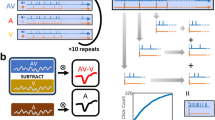Abstract
Auditory evoked potentials (AEPs) were studied from scalp locations Cz and Oz on 37 adults aged 20–22 years during sensori-sensorial association of a weak sound (S) and a strong flash of light (L). After sound alone repetition (habituation), S-L association modified AEP: first, it caused a generalized orienting response expressed as increasing of Cz and Oz amplitude AEPs. Then, this pattern gave way to an activation limited to the Oz lead: the increase of amplitude was then concomitant with shortened latencies when compared to sound-alone-habituated responses. Inter-individual differences were observed since these occipital modifications were recorded only on 26 subjects. The other 11 subjects did not exhibit any occipital modifications following S-L association. For them, the main modification was a strong decrease of Cz AEP induced by S-L association.
These two groups also differed in their capacity to ignore irrelevent stimuli which is higher in the first group (AEP amplitude habituation with sound-alone repetition) than in the second one (no AEP habituation).
Similar content being viewed by others
References
Bryson, C. Q. (1970) Systematic identification of perceptual disabilities in autistic children.Perceptual and Motor Skills, 31, 239–246.
Buchsbaum, M. S., and Fedio, P. (1969). Visual information and evoked responses from the left and right hemispheres.Electroencephalography and Clinical Neurophysiology, 26, 266–272.
Callaway, E. (1975) Brain electrical potentials and individual psychological differences. Grune and Stratton (Eds.), New York, pp. 214.
Dykman, R. A. (1987) Event-Related Potentials (ERPs) in simple conditioning paradigms. R. Johnson, Jr., J. W. Rohrbaugh and R. Parasuraman (Eds.),Current Trends in Event-Related Potential Research. Elsevier Science Publishers B. V.: pp 311–315.
Fishman, M. C., and Michaël, C. R. (1973) Integration of auditory information in the cat’s visual cortex.Vision Research, 13, 1415–1419.
Hernandez-Peón, P. (1960) Neurophysiological correlates of habituation and other manifestations of plastic inhibition (internal inhibition).Electroencephalography and Clinical Neurophysiology, 13, 101–114.
Lelord, G., Calvet, J., Fourment, A., et Scherrer, J. (1958) Le conditionnement de la réponse évoquée électrocorticale chez ol’homme.Comptes Rendus de la Société Biologie (Paris), 152, 1092–2000.
Lelord, G., et Maho, C. (1969a) Modifications es activités évoquées corticales et thalamiques au cours d’un conditionnement sensoriel. I. Localisation des réponses et variations avec la vigilance.Electroencephalography and Clinical Neurophysiology, 7, 258–269.
Lelord, G., et Maho, C. (1969b) Modifications des activitiés évoquées corticales et thalamiques au cours d’un conditionnement sensoriel. II. Evolution des réponses avec les stades du conditionnement.Electroencephalography and Clinical Neurophysiology, 7, 270–279.
Lelord, G. (1972) Conditionnement sensoriel, électrophysiologie et psychiatrie. A. Fessard and G. Lelord (Eds.). Colloque INSERM. Activités évoquées et leur conditionnement chez l’homme normal et en Pathologie Mentale. INSERM, Paris: pp 253–293.
Morell, F. (1971) Specificity of non-visual input to visual cortical neurons.Electroencephalography and Clinical Neurophysiology, 31, 413–420.
Paige, S. R., Newton, J. E. O., Reese, W. G., and Dykman R. A. (1987) Pavlovian conditioning of cortical event-related potentials. R. Johnson, Jr., J. W. Rohrbaugh and R. Parasuraman (Eds.)Current Trends in Event-Related Potential Research. Elsevier Science Publishers B. V: pp 355–359.
Polyansky, V. B., Sokolov, E. N. and Polkoshnikov, E. V. (1975) Light-sound interaction in the neurons of the rabbit’s visual cortex.Acta Neurobiologiae Experimentalis, 35, 51–76.
Roux, S. (1981) Aspects électrophysiologiques du conditionnement des potentiels corticaux évoqués par des stimulations sensorielles chez l’homme.Doctorat dissertation, third cycle, Poitiers.
Roth, W. T. (1973) Auditory evoked responses to unpredictable stimuli.Psychophysiology, 10, 125–138.
Rust, J. (1977) Habituation and the orienting response in the auditory evoked potential.Psychophysiology, 14, 123–126.
Sokolov, E. N. (1963) Perception and the conditioned reflex. London: Pergamon press.
Sokolov, E. N., Polyanski, V. B., and Bagdonas, A. (1970) Dynamics of the single unit reactions in the visual cortex of the unanesthetized rabbit.Vision Research, 10, 11–28.
Walter, W. G. (1964) The convergence and interaction of visual, auditory and tactile responses in human non-specific cortex.Annals of the New York Academy of Sciences, 112, 320–361.
Author information
Authors and Affiliations
Additional information
This study was supported by grants from INSERM n° 859014, Fondation pour la Recherche Médicale, Fondation H. Langlois, Séurité Sociale and Conseil Régional de la Région Centre.
Rights and permissions
About this article
Cite this article
Bruneau, N., Roux, S., Garreau, B. et al. Cortical evoked potentials as indicators of auditory-visual cross-modal association in young adults. Pav. J. Biol. Sci. 25, 201–206 (1990). https://doi.org/10.1007/BF02900703
Issue Date:
DOI: https://doi.org/10.1007/BF02900703




